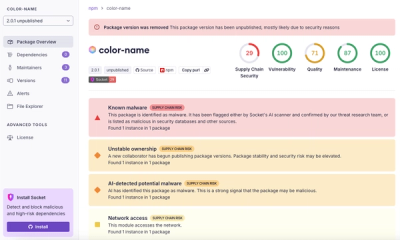
Research
/Security News
npm Author Qix Compromised via Phishing Email in Major Supply Chain Attack
npm author Qix’s account was compromised, with malicious versions of popular packages like chalk-template, color-convert, and strip-ansi published.
= Ruby Setup
{Website}[http://rubyworks.github.com/setup] /
{Guide}[https://github.com/rubyworks/setup/wiki] /
{Issues}[http://github.com/rubyworks/setup/issues] /
{Source}[http://github.com/rubyworks/setup]
( { }[http://travis-ci.org/rubyworks/setup] )
}[http://travis-ci.org/rubyworks/setup] )
== Introduction
Every well practiced Rubyist is aware of Minero Aoki's ever +setup.rb+ script. It's how most of us used to install our Ruby programs before RubyGems came along. And it's still mighty useful in certain scenarios, not the least of which is the job of the distro package maintainer.
Ruby Setup converts setup.rb into a stand-alone application. No longer requiring the distribution of the setup.rb script with every Ruby package. Just instruct one's users to install Ruby Setup (gem install setup) and go from there. As long as a project is setup.rb compliant, as most are, then there is little to nothing it's developer must do.
=== Important
There a couple very important difference between the old 3.4.1 verison of the setup.rb and Ruby Setup.
== Installation
The easy way to install is via RubyGems.
$ sudo gem install setup
To install Setup manually you need to "boot-strap" it. Download the tarball, and from the decompressed package directory run:
$ ruby script/setup
== Instruction
To use setup.rb, a project must conform to the setup.rb standard layout. Please see the documentation on the website if you need to know more about what this entails. Most projects already follow the standard since it was setup.rb that originally popularized most of the current layout conventions. (Note that the on-line documentation is slightly out of sync with the latest release.)
Usage is as simple as:
$ setup.rb
This is the same as using the all subcommand.
$ setup.rb all
And is equivalent to running the two main phases in sequence.
$ setup.rb compile $ setup.rb install
Where +compile+ compiles any extensions and +install+ copies project files to the appropriate places on your system.
For setup.rb to install a project's documentation and library files
properly it is best to supply it was basic information about the project.
In particular, the +name+, +version+ and +loadpath+ (if not the default lib).
This can be done either by creating a .index file for the project
(see {Indexer}[http://github.com/rubyworks/indexer]), or by adding
.setup/name, .setup/version and .setup/loadpath
to the project.
Setup.rb also supports two optional phases, +config+ and +test+.
$ setup config
Configuration must be run before any other phase in order to be of
used. Running config creates a SetupConfig file which you can then
edit to make any adjustments neccessary to the installation. When finished
editing this file, use setup.rb as before and your custom configuration
will be used instead of the standard defaults.
$ setup.rb test
This will run tests if a test script is provided. It must be run after +compile+, but before +install+. Because there are now a deverse selection of testing tools available for Ruby, testing only happens if the developer has provided a test runner script, either. .setup/test.rb or .setup/test.sh. Keep in mind that testing may require support libraries such as RSpec, Lemon, Bacon, QED or Cucumber. When using the +all+ command, you can activate testing via the --test or -t option.
If you later decide you want to remove a program from your system, use +uninstall+.
$ setup.rb uninstall
This will remove all files previously installed via the setup.rb command. Uninstalling is made possible by the 'SetupReceipt' file that is generated by the install process. If that file is deleted than you will not be able to uninstall. (You can usually get around this be reinstalling first though).
During the make phase, by-product files are typically created. You can clean up any of these by-products with:
$ setup.rb clean
And restore them to their absolute pristine state with:
$ setup.rb distclean
For further details on using +setup.rb+, or developing a project that can take advantage of setup.rb's special features, please see the website and associated wiki.
== Copyrights
Setup.rb is copyrighted open source software.
Copyright (c) 2008 Rubyworks (BSD-2-Clause)
It can be modified and redistributed in accordance with the BSD-2-Clause license.
Setup.rb is a rewrite of the original setup.rb script by {Minero Aoki}[http://i.loveruby.net].
Copyright (c) 2002 Minero Aoki (GNU LGPL 2.1+)
See LICENSE.txt and NOTICE.rdoc for details.
FAQs
Unknown package
We found that setup demonstrated a not healthy version release cadence and project activity because the last version was released a year ago. It has 2 open source maintainers collaborating on the project.
Did you know?

Socket for GitHub automatically highlights issues in each pull request and monitors the health of all your open source dependencies. Discover the contents of your packages and block harmful activity before you install or update your dependencies.

Research
/Security News
npm author Qix’s account was compromised, with malicious versions of popular packages like chalk-template, color-convert, and strip-ansi published.

Research
Four npm packages disguised as cryptographic tools steal developer credentials and send them to attacker-controlled Telegram infrastructure.

Security News
Ruby maintainers from Bundler and rbenv teams are building rv to bring Python uv's speed and unified tooling approach to Ruby development.